#shusu silk
Text
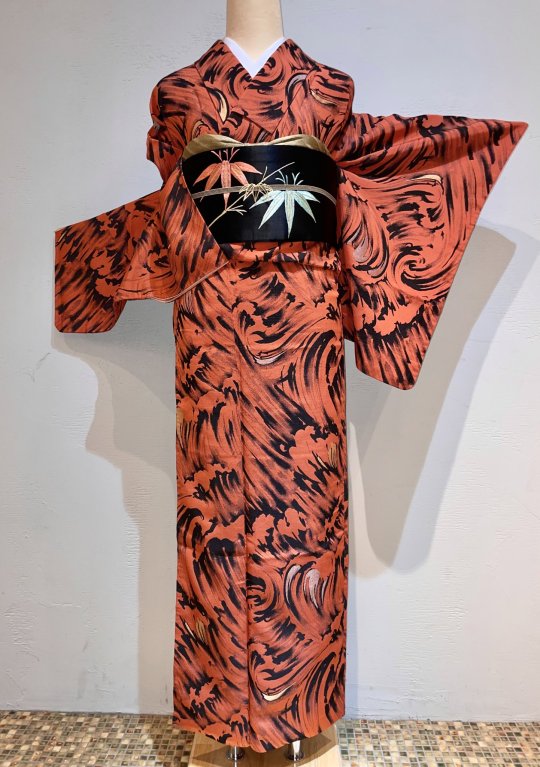



Festive red for this outfit, pairing a kimono with dynamic brush-like swirls, with an antique black base obi depicting an Ise-ebi among bamboo leaves.
Ise ebi (Japanese spiny lobster) are an auspicious creature part of New year osechi ryôri celebratory dishes: their bent back make them look like an old person, hence why they symbolize wishes for long life :)
#japan#fashion#kimono#obi#ebi#ise ebi#lobster#spiny lobster#prawn#shrimp#brush stroke#bamboo#take#sasa#leaves#New year in japan#shusu silk#black satin#osechi ryori
297 notes
·
View notes
Note
Except for many extra layers and no pattern, are kimono for tayu exactly like geisha's? Are there differences in structure or any other relevant one between both?
The structure of all kimono is the same, but tayū kimono are made very differently from a geisha's. Tayū kimono are made from thick, shusu silk and are heavily padded along the bottom whereas geisha use normal silks that are, at most, lightly padded along the bottom. Tayū kimono are uchikake types while geisha wear hikizuri or houmongi ^^
15 notes
·
View notes
Text
Techniques
Types of Techniques: Wow I Wish I Had the Means To Do Any of These
Gold Foils
Surihaku
“Printed foil” or “impressed foil”
Originated in the Nara Period
How: paste is applied to fabric (shusu or rinzu satin) over a stencil. The stencil is removed and while the paste is still wet the foil is applied. Any extra is brushed away
Cloth used is usually a deep red, purple, or indigo
Rose to popularity in Muromachi period due to imports
Not many extant garments, as the foil by this time has flaked away
Used often for Noh costumes
Nuihaku
Combo of surihaku and embroidery
Done to give the designs more depth

Photo Source
second half of the 18th–first half of the 19th century
Embroidered silk satin
Egret and Willow Tree The Met Museum
Tsujigahana
Combo of tie-dye, hand-painting, and surihaku
Came about during Muromachi to Azuchi-Momoyama Period in Kyoto

Photo Source
late Momoyama period
Plain-weave silk with resist dyeing and ink painting
Horizontal Stripes, Flowering Plants, Fans, Snowflakes, Clouds, and Bellflowers The Met Museum
Woven Designs
Aya
Twill
Rinzu
Figured satin
Nishiki
Weft and weave threads are different colors
Kinran/Ginran
Gold/silver threads used in weft/weave
Tsuzure-ori
Tapestry weave
Ukimon-ori
“Floating-design weave”
Long lengths of thread are “floated” on the surface of the fabric
Can still be seen in obi designs
Noshime
Striped fabric weave

Photo Source
Meiji Period
Noshime Furisode with Dragons and Clouds in Cloud-Silhouette Band on Dark Brow
Kyoto National Museum
Dyeing and Printing
Kokechi
“Tie-dyeing”
Shibori
A type of non-wax resist dyeing
Fabric is wound with cord and dyed in indigo
Nuishime-shibori
Fabric is sewn together and then dyed
Created during the Muromachi Period
Nui-shibori
Combo of shibori and embroidery
Murago
Different shades of the same color merge into each other
Rokechi
Wax-resist dyeing
Kyokechi
Block-resist dyeing
Kata-zome
Combo of stencil dyeing and block printing
Used during the Nara Period
Gave way to “Komon” (small pattern)
Yuzen-zome
Created by Miyazaki Yuzensai (Kyoto Yuzen)
How: a design is painted on the cloth with paint and dyestuffs, fixed with a liquor made of beans, and sealed with a paste made of rice before the surrounding area is dyed.
At the same time Miyazaki was working in Kyoto, this technique was also being discovered at the same time in Kanazawa in Kaga Province
Kaya yuzen
Bright colors
Considered more charming
Kyoto yuzen
Darker colors
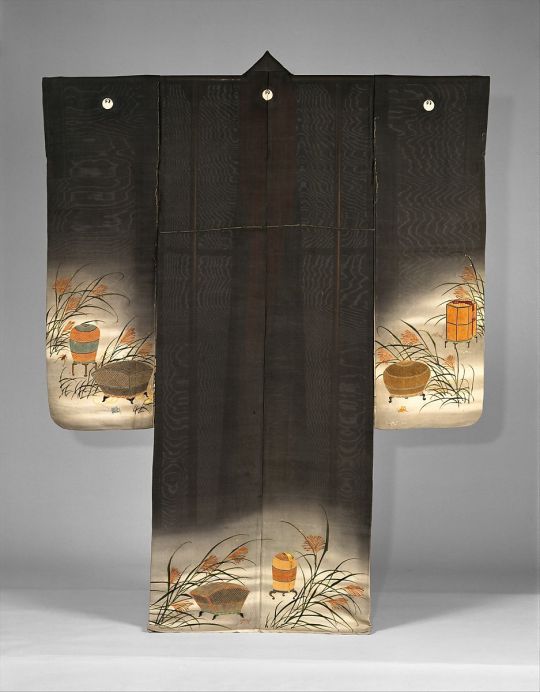
Photo Source
Early Meiji period
Paste-resist dyed (yūzen) and painted silk gauze with embroidery
Unlined Summer Kimono (Hito-e) with Crickets, Grasshoppers, Cricket Cages, and Pampas Grass The Met Museum
Kirihame
Applique and patchwork
[on the topic of Japanese color culture]
“The same preference for gradual change is the reason a shade of grey called usu-nibi-iro was worn for morning rather than black. It represented not a sudden descent into the dark of night, but a gradual transition into twilight.” P.161
Part 5
#kimono#kimonos#historical#historical fashion#japanese historical fashion#japanese designs#japan#research#research notes#textiles#dyeing#fashion
6 notes
·
View notes
Photo


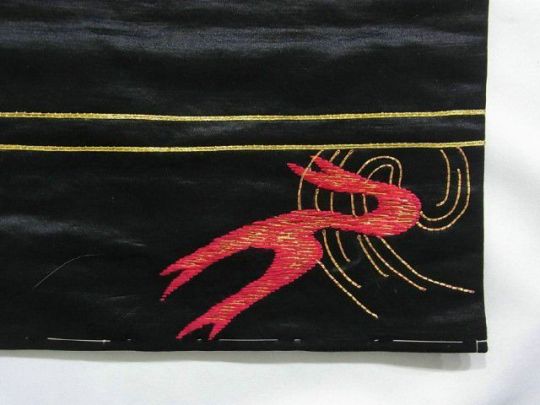

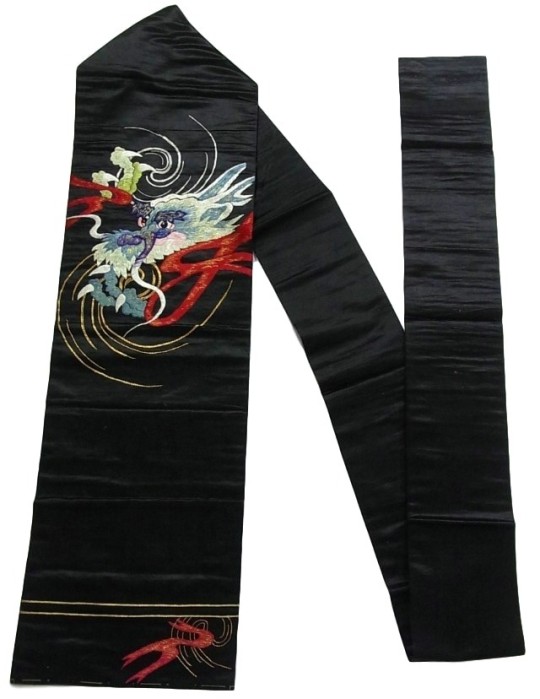





Gorgeous Embroidery Dragon Design Vintage Nagoya Obi This is a vintage Nagoya obi with a design of dynamic dragon, which is embroidered.
Kinkoma(golden outlining) and ginkoma(silver outlining) embroidery works are added to the vibrant design against the black background.
Textile is shusu(satin) silk and jinken (rayon) blend.
Thin cotton fabric is attached on the wrong side of otaiko.
http://www.ichiroya.com/
1 note
·
View note
Video
youtube
Traditional Weaving in Nishijin, district of Kamigyō-ku in Kyoto, Japan
1. Produced in Kamigyoku Kyoto City, Kyoto-Fu.
2. Characteristics: The name "Nishijin"(west position) came about because these gorgeous fabrics were produced in the area in Kyoto where the position of an army, then called "West Army" was in a civil war("Onin no Ran") which lasted 10 years, ending in 1477. As it is woven with threads of many colors, "Nisahijin Ori" is a gorgeous and brilliant fabric representative of Japanese textiles. More than 150 ways of weaving are used to achieve the varieties of fabrics: in general, however, 2 kinds;"Mon Ori" and "Tsuzure Ori." As far as the sashes are concerned, "Nishijin" is one of the 3 cities producing quality sashes.
3. Uses: Sashes, clothing, gold brocades, thick curtains, interior and textile art.
4. History: The history of "Nishijin Ori" is only 500 years old, but that of silk fabrics in this area is older and with much ups and downs. A Korean named Hata, with some 1,000 Koreans settled here and started sericulture and silk weaving in the 5th or 6th century. When the capital was moved here in 794 and the Fabric Office was established, Kyoto developed into a flourishing center of fabrics for imperial families, nobilities and court officials. Such quality fabrics were woven as "Ra" and "Sha"(gauze), "Aya"(figured twill), "Kome Ori"(kind of gauze) and "Nishiki"(brocade).
In the Muromachi Period, Kyoto became a battlefield as a civil war broke out. Weavers left here for Nara and Sakai but came back after the war. They established a weaverユs guild, resuming the production here. As the Ashikaga Shogunate protected it, Nishijin weaving reached an extensive development. In the Azuchi Momoyama Period(1568-1600) production of many kinds of weaving was possible due to the patronage of a warrior ruler Toyotomi and trade with China. Through the Chinese came the technique of weaving "Kinran"(rich brocade with gold threads), "Donsu"(damask) and "Shusu"(satin).
The weaving industry declined off and on in 1730 and again in 1788 due to a big fire in Kyoto. After that, however, the industry was revived because of the weaversユ efforts in developing the techniques and the quality and also because of the townsmen class, now rich, supported the industry. Thus, Nishijin became the center of quality fabrics. The industry continued to prosper even after the Jacquard machine was imported in the Meiji Period. Nishijin has been the greatest center of the silk fabric industry. "Tsuzure Ori" is a technique in weaving designs in plain weaves with thick twist yarns as weft. A sketch of the design is placed under the warp in the loom and the weaver puts in the weft while looking at the design through the warp. The weft in general is woven by using a reed with the width of the fabric. In "Tsuzure Ori," however, colored threads, including gold and silver, are woven into the design. The weaversユ nails are shaped like saw teeth and used for fixing the threads into the design. Therefore, "Tsuzure Ori" is also called "Tsume(nail) Tsuzure." -Source: http://www.kimono.or.jp/dictionary/en...
Video Credit: TEWAZA - Traditional Crafts Aoyama Square
4 notes
·
View notes
Photo

Fukusa (Gift Cover)
Japan, late Edo period (1789–1868), early 19th century
Patterned side: silk, warp-float faced 4:1 satin weave (shusu); embroidered with silk and gold-leaf-over-lacquered-paper-strip wrapped silk in Chinese knot, satin, single satin, surface satin, stem and straight stitches; paper-strip wrapped cotton padded satin stitches; laidwork and couching; painted India ink (sumi) details
Lined (re-lined) with silk, plain weave with creped wefts (chirimen); interlined with cotton; plain weave; padded with waste silk
Sewn with padded lining extending beyond front at center on all four side (Yatsuzuma); silk, running "controlling" stitches along edges
Art Institute of Chicago
10 notes
·
View notes
Text

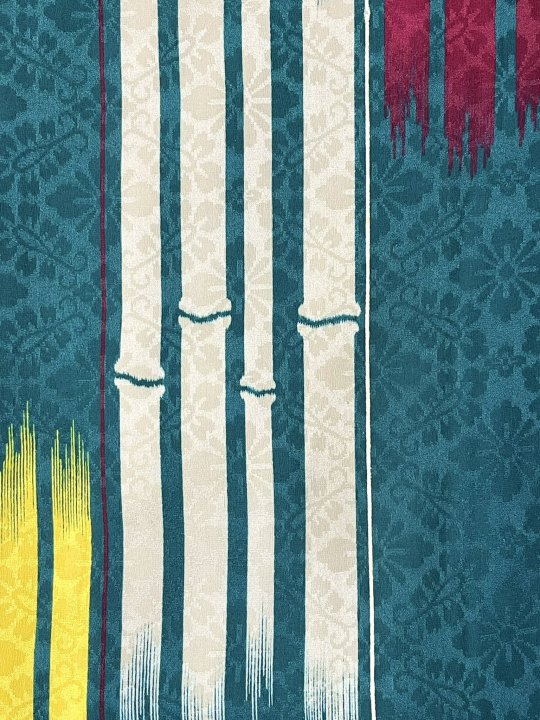
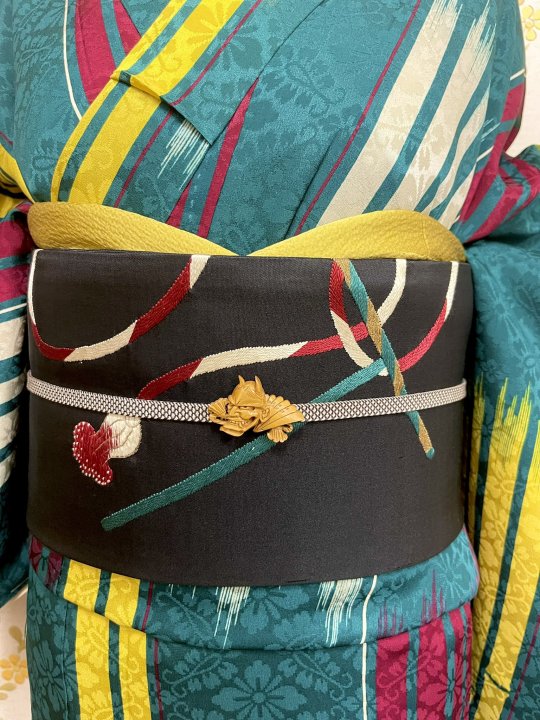

Holidays colors yes but with a twist :D
Beautiful color matching for this antique outfit, pairing a kimono with bamboo stalks over a ground of hanakatsumi (geometrical leaves and flowers pattern), with a fantastic black-based obi with a snarling hannya noh mask.
#japan#fashion#kimono#obi#hannya#mask#noh mask#noh#bamboo#take#hana katsumi#hanabishi#diamond shaped flower#shusu silk#black satin#着物#帯
208 notes
·
View notes
Text


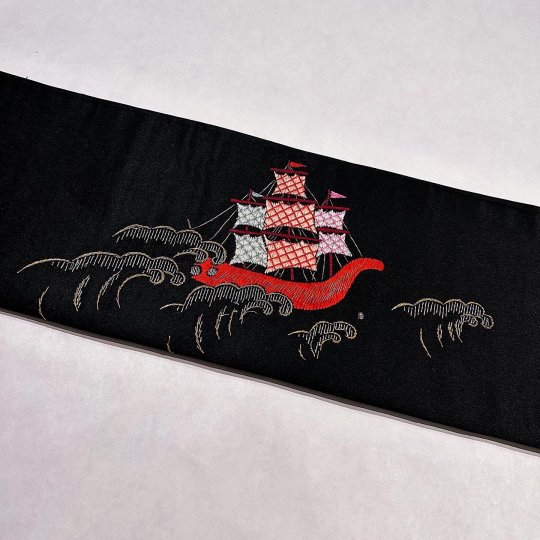

Dynamic wavy patterns for this antique outfit, pairing a bold kimono with scattered kiku (chrysanthemum), and a black-based satin obi with embroidered nanbansen (foreign trade ship, especially Portuguese or Dutch ones).
147 notes
·
View notes
Text






Colors of autumn antique outfit, with an unsual black-base satin obi with hanpainted foliage and embroidered colorful bird + juicy persimmons.
I am in love with the maple leaves kimono, pairing shadow leaves ground with just the right splash of rusty leaves here and there <3
#japan#fashion#kimono#obi#autumn in japan#kaki#persimmon#bird#tori#momiji#maple leaves#shusu silk#black base obi#帯#着物
138 notes
·
View notes
Text


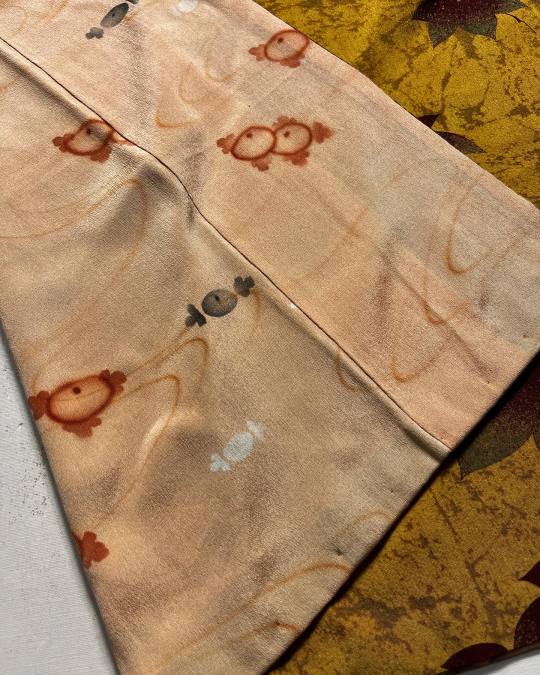

Rare pattern for this red chôchin (paper lantern) black-based satin antique obi! I believe I never saw a kimono item with a lantern as main subject, this is really cool :3
This hand-held lantern with a simple handle (here made from bamboo) is called ぶら提灯 burachouchin. Many other types existed, like the bow-shaped handle sturdier yumiharichouchin, or the umanorichouchin meant to be used on horseback.
#japan#fashion#kimono#obi#chouchin#chochin#paper lantern#red lantern#bura chouchin#yumihari chouchin#umanori chouchin#shusu silk#black base obi#着物#帯
116 notes
·
View notes
Photo
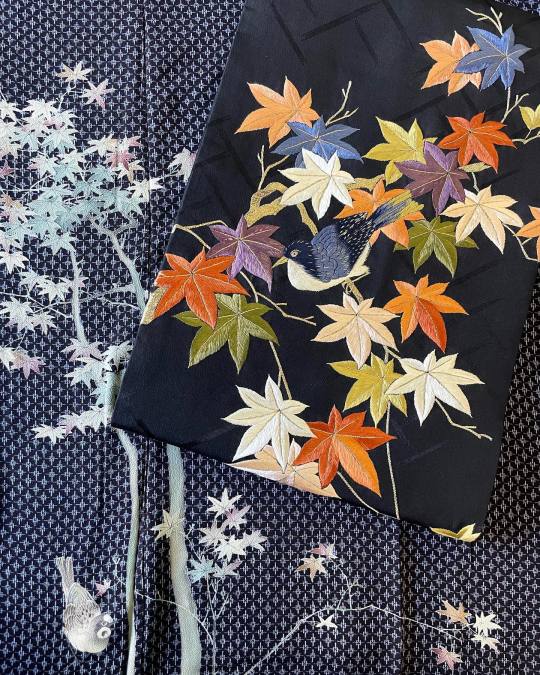
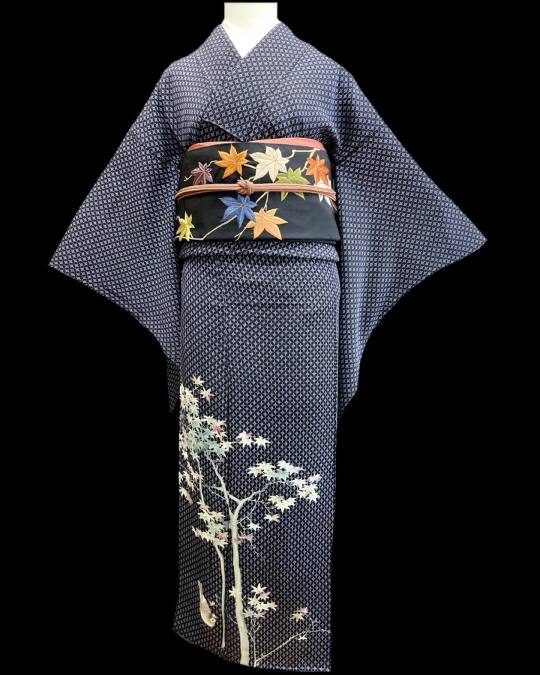
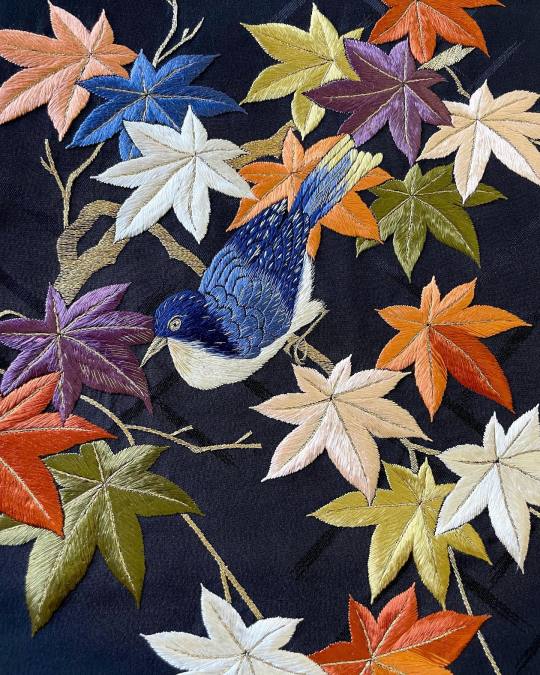
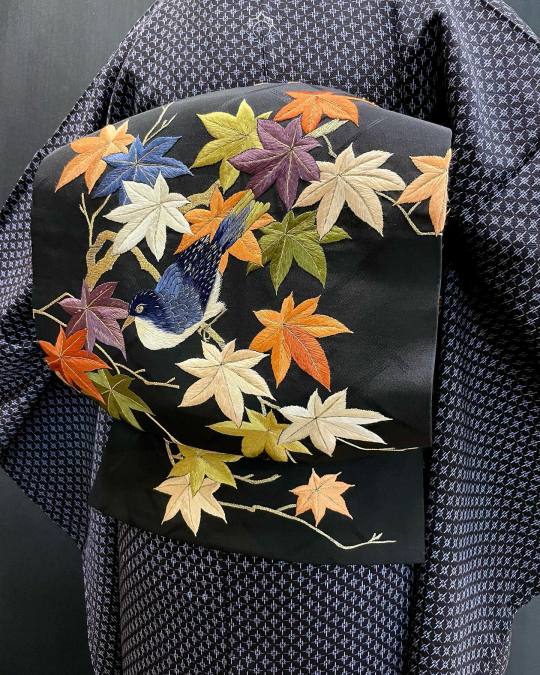
Romantic antique attire perfect for kôyô (autumn leaves viewing season) depicting small birds in turning maples trees.
The black silk shusu obi is matched with a lovely sanpogi (lit. ”stroll outfit”). Those were beautiful kimono featuring mirror designs on skirt flaps and all over patterns. I believe they were worn as fashionable day dress and were briefly in fashion in Kansai (Osaka?) pre wwii.
446 notes
·
View notes
Photo



Angry looking white rabbit embroidered with horsetails on black satin obi, paired with a retro tsubaki (camellia) kimono.
I’ve not stressed this tidbit in a while so let’s go: in traditional kimono fashion, black, white and red are all considered “neutral” colors ;)
#japan#fashion#kimono#obi#rabbit#white rabbit#moon rabbit#bunny#horsetail#tokusa#tsubaki#camellia#shusu silk#black satin#着物#帯
188 notes
·
View notes
Photo




Comforting autumnal outfit, pairing a lovely tsuta (ivy) over bamboo ground kimono, with a shimarisu (tamia/chipmunk) in grapevine shusu silk obi
#japan#fashion#kimono#obi#autumn in japan#tsuta#ivy#shimarisu#tamia#chipmunk#risu#grapevine#budou#shusu silk#着物#帯
371 notes
·
View notes
Photo

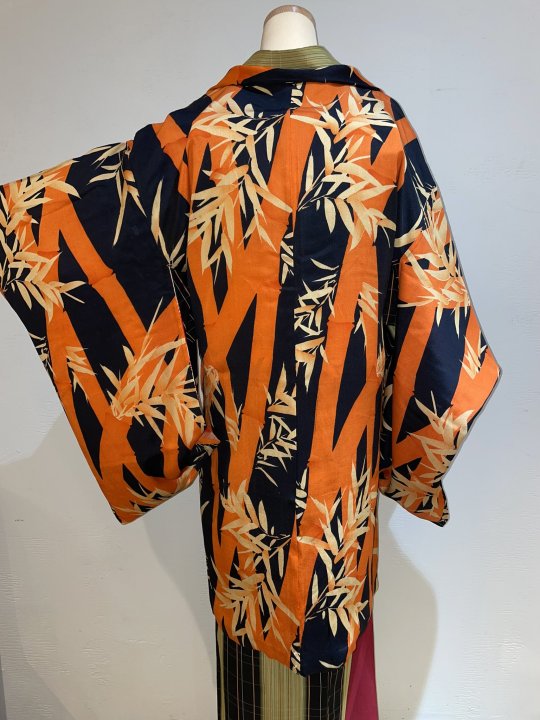
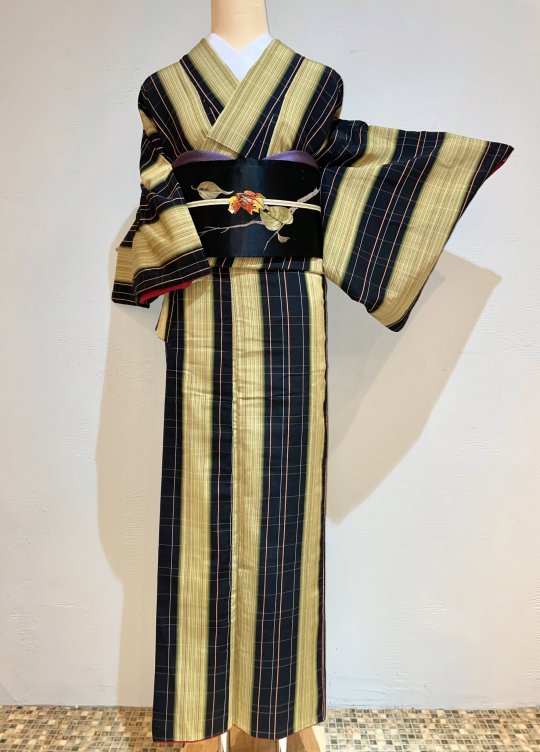
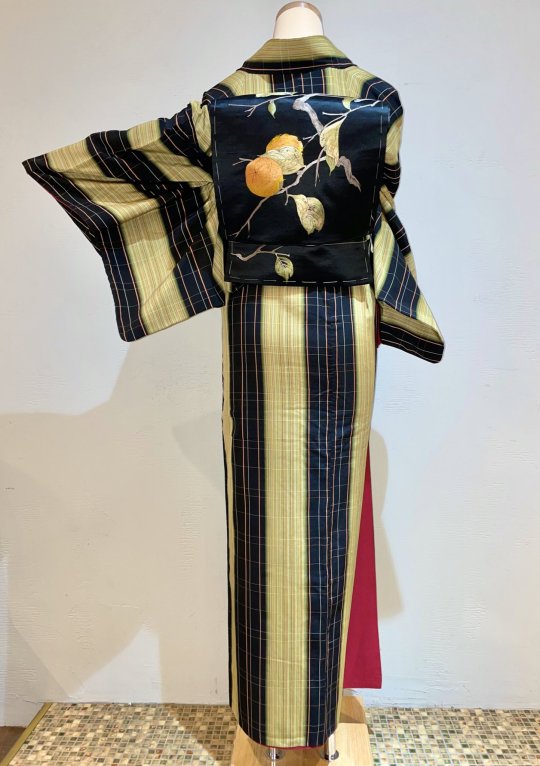


Brilliant autumn hues for this take (bamboo) patterned haori (with peacock feathers on lining). OP chose to pair it with a kimono with discreet checkered pattern, and a lovely black satin obi with embroidered kaki (persimmon). Perfect nostalgic sato no aki (autumn countryside/village) mood!
#japan#fashion#kimono#obi#haori#take#bamboo#kaki#persimmon#shusu silk#autumn in japan#winter in japan#着物#帯#羽織
343 notes
·
View notes
Photo



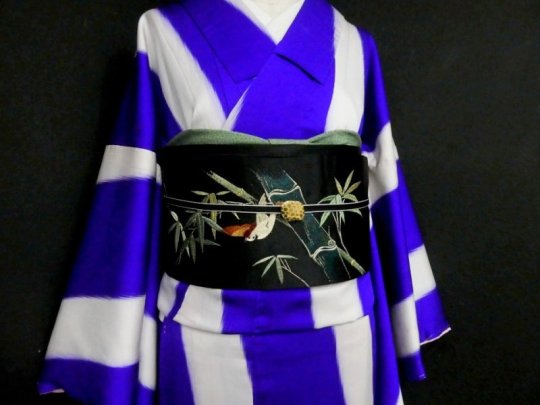

Lovely retro outfit, pairing a beautiful kimono with diagonal lines, with a black satin obi with a seasonal scenery of kansuzume (lit. cold sparrow) fluttering in take (bamboo)
#japan#fashion#kimono#obi#winter in japan#kan suzume#suzume#cold sparrow#sparrow#take#bamboo#shusu silk#black satin#着物#帯
147 notes
·
View notes
Photo


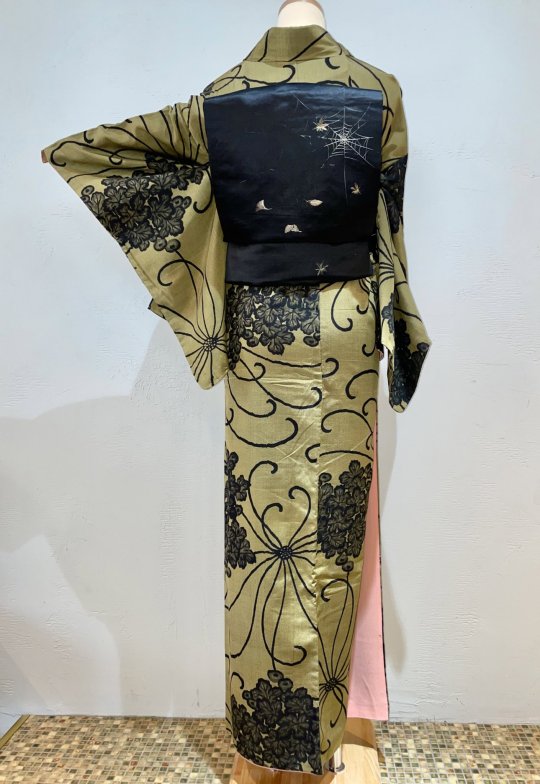

Goth romance feeling for this autumny outfit, featuring a kimono with delicate spidery mums, paired with an antique shusu silk obi with embroidered spiderwebs and fukiyose (wind blown leaves). The moth obidome looking entangled in the web is the most perfect accessory for this belt!
#japan#fashion#kimono#obi#autumn in japan#spider mum#kiku#chrysanthemum#shusu silk#spiderweb#spider#kumo#fukiyose#wind blown leaves#moth#obidome#halloween#goth#着物#帯
222 notes
·
View notes